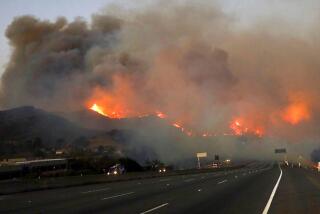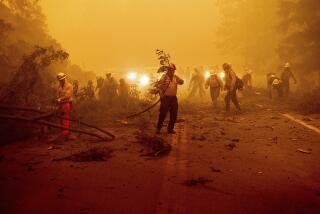L.A. Seeks Bond Issue to Pay for Fire Sprinklers
- Share via
Acknowledging the steep cost of retrofitting high-rises with automatic fire sprinklers, the Los Angeles City Council voted Tuesday to go to the voters for approval to finance sprinklers, asbestos removal and other safety measures for six city-owned buildings.
On a 15-0 vote, the council ordered the drafting of a bond measure for the April, 1989, primary election that could provide more than $30 million if passed. The council also unanimously authorized $5 million in start-up work over the next year, which will include some asbestos removal, design costs and installation of some unrelated construction such as restroom wheelchair access.
The retrofitting bond measure faces two major hurdles. First, it would require two-thirds approval for passage, a threshold that has often doomed bond issues.
Second, voters would not confront the measure until April 4, 1989, nearly a year after the recent First Interstate Bank fire that resulted in tens of millions of dollars in damage, one death and 40 injuries. Fire officials have often lamented that public interest in safety reforms wanes with the passage of time, regardless of the magnitude of the disaster that inspires them.
Time Constraints
City officials said Tuesday that there is not enough time to determine the precise costs of sprinkler retrofitting and related costs in time for the November ballot.
Both the council and Mayor Tom Bradley have called for retrofitting of both private and public high-rises that are at least 75 feet in height and built before a 1974 state law required sprinklers in all new office towers. In addition, Bradley has proposed that older high-rises install fire-resistant doors in elevator lobbies and a ventilator hole at the top of all stairways.
A key reason cited by council members for including the city-owned high-rises in the retrofitting proposal was to set an example for the private building owners. Building owners, with some reservations, have endorsed the mandatory retrofitting idea.
Councilman Nate Holden said that with or without voter passage of the bond issue the city is committed to sprinkler retrofitting and will find a way to pay for it.
That will be a tall order. City officials roughly estimated last week that it could cost about $35 million to install automatic sprinklers, remove asbestos, enclose open stairways and place other fire safety devices in the six buildings: City Hall, City Hall East, City Hall South, Parker Center police headquarters and the City Hall branches in Van Nuys and San Pedro.
$13 Million Estimate
The cost of sprinkler retrofitting alone was estimated at about $13 million, more than twice the amount originally thought.
Council members expressed concern over the steep estimates because they were significantly higher than the price that First Interstate Bank was charged for the sprinkler system that it was having installed at the time of the fire. And they were not assuaged by explanations that because of the historic architecture at City Hall, for instance, sprinkler installation would be more difficult than in a contemporary high-rise.
Tuesday’s action reflected the concerns over the steep prices, whatever they might eventually be. It also showed an unwillingness on the part of the council to commit massive amounts of money unless absolutely necessary.
Brookes Treidler, assistant General Services Department general manager, said that the $5 million, subject to Bradley’s approval, would be spent over the next several months to design the sprinkler systems, perform engineering studies, install wheelchair access to some public restrooms, enclose some stairways and begin asbestos removal in City Hall East.
In other budget action Tuesday, the council on a 5-10 vote, defeated a motion by Councilwoman Joy Picus to decrease to 9% the current 10% utility tax charged city residents for electricity, natural gas and telephone use. Passage would have cost the city treasury an estimated $15.4 million.
More to Read
Sign up for Essential California
The most important California stories and recommendations in your inbox every morning.
You may occasionally receive promotional content from the Los Angeles Times.










